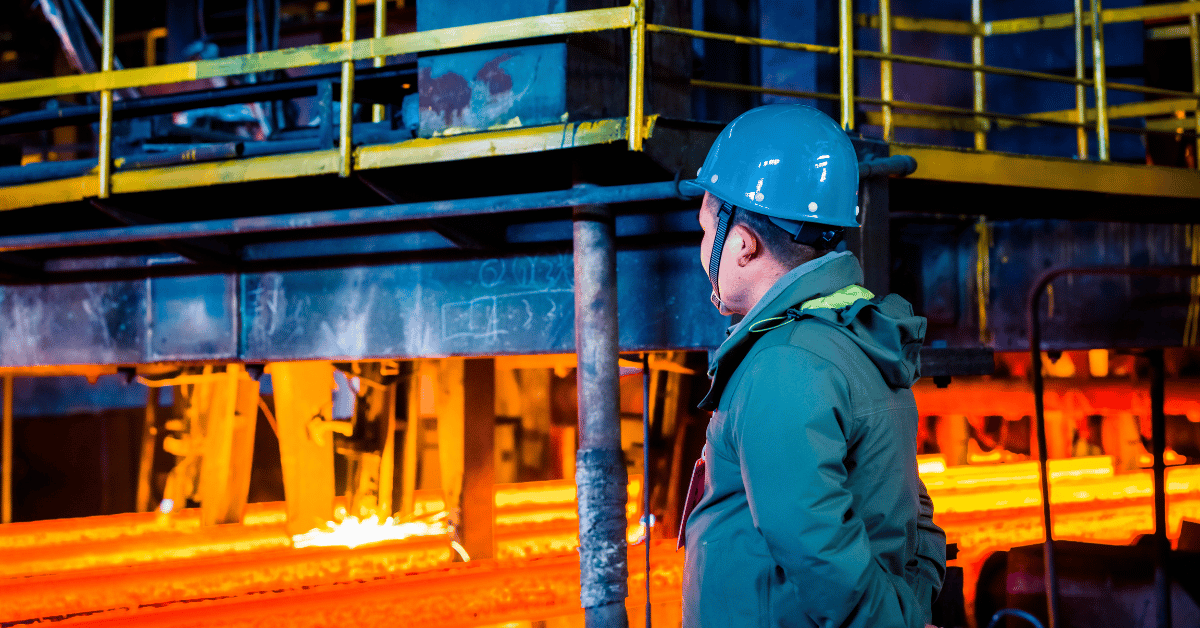Iron saturate, in the context of material science, refers to the state where iron’s magnetic domains are fully aligned, reaching its maximum magnetic flux density. This property is critical in understanding how iron behaves in electromagnetic applications, metallurgy, and advanced manufacturing. In simpler terms, once iron reaches saturation, increasing the magnetic field no longer increases magnetization. This phenomenon is vital in designing transformers, electric motors, magnetic storage devices, and advanced alloy production. Understanding iron saturation also aids in predicting material limits and improving performance in industrial systems. For engineers, metallurgists, and product designers, grasping iron saturation means unlocking new ways to optimize energy efficiency and durability in various technologies. It also has implications in metallurgy for controlling the crystalline structure during alloy production. This article will explore the science behind iron saturate, its applications, measurement methods, and industrial significance, while also highlighting modern advancements that push the limits of this material property in both research and practical engineering.
The Science Behind Iron Saturation
At its core, iron saturation is a phenomenon tied to the arrangement of magnetic domains within a piece of iron. These microscopic regions naturally align in different directions, producing an overall magnetic effect. When an external magnetic field is applied, the domains begin to align uniformly. However, there comes a point where every possible domain is aligned — this is the saturation point. Beyond this stage, applying more magnetic force will not significantly enhance the magnetization. The concept is deeply rooted in quantum mechanics and solid-state physics, where electron spin and orbital motion influence magnetic properties. Material scientists study this saturation threshold to determine performance parameters for magnetic cores and components in power electronics. Understanding the saturation curve of iron is particularly useful in preventing energy losses, designing more efficient transformers, and avoiding overheating in magnetic machinery. Without mastering this principle, engineers risk overdesigning systems that waste both materials and energy.
Magnetic Domains and Their Alignment
Iron’s magnetic properties are governed by the concept of domains — tiny regions where atomic magnetic moments are aligned in the same direction. In an unmagnetized state, these domains are randomly oriented, canceling out the overall magnetic effect. When subjected to a magnetic field, domains shift and reorient themselves, increasing net magnetization. As the field intensifies, more domains align until nearly all point in the same direction. This stage marks the iron saturation point. Interestingly, domain wall movement is more pronounced at lower field strengths, while at higher strengths, only the rotation of moments contributes to magnetization. For industrial designers, knowing how domains behave helps predict how iron-based components will respond to varying magnetic loads. This is particularly crucial in industries like renewable energy, where magnetic cores in wind turbine generators must operate below saturation levels to maintain efficiency. In essence, domain alignment dictates the operational limits of magnetic iron in real-world applications.
Role of Iron Saturate in Electromagnetic Devices
Electromagnetic devices such as transformers, inductors, and electric motors rely heavily on the predictable magnetic behavior of iron cores. Saturation is a key limiting factor in their design. Once the core reaches saturation, any additional current fails to produce proportional increases in magnetic flux, resulting in inefficiencies and potential overheating. For instance, in transformer design, engineers carefully select core materials with higher saturation points to allow greater operational flexibility. Iron saturate also influences signal integrity in inductors used for telecommunications and power conditioning. In electric motors, avoiding saturation ensures smoother torque generation and prevents power losses under heavy load conditions. This makes knowledge of iron saturate indispensable for electrical engineers aiming to optimize performance while minimizing energy waste. Furthermore, modern electric vehicles depend on finely tuned saturation thresholds in their motor cores to deliver both power and efficiency in compact, lightweight designs.
Table 1: Key Parameters of Iron Saturation in Magnetic Materials
| Parameter | Typical Value for Pure Iron | Industrial Significance |
|---|---|---|
| Saturation Magnetization (Ms) | ~2.15 Tesla | Determines maximum magnetic flux in devices |
| Coercivity | Low (~0.05 Oe) | Easier to magnetize and demagnetize |
| Curie Temperature | ~770°C | Above this, magnetic properties vanish |
| Magnetic Permeability | High (~5000 µH/m) | Enhances inductive efficiency |
Iron Saturation in Metallurgical Processes
Beyond electromagnetics, iron saturation plays a role in metallurgy, particularly in alloy formation. During smelting and refining, controlling iron saturation helps dictate the crystallographic arrangement of the final metal. This affects hardness, ductility, and corrosion resistance. In certain steels, the magnetic saturation point is considered during design because it correlates with grain orientation, which in turn influences both mechanical and magnetic properties. Alloying elements such as silicon or nickel can shift the saturation point, making the iron suitable for specialized uses such as electrical steel or soft magnetic alloys. Metallurgists study saturation to optimize heat treatment processes, ensuring that magnetic and mechanical performance targets are met simultaneously. In industries like aerospace or precision engineering, fine control over saturation-related properties can lead to lighter yet stronger components. These factors make saturation an important, though sometimes overlooked, consideration in advanced material development.
Applications in Magnetic Storage and Data Systems
Iron saturate also plays a role in the technology behind magnetic storage systems. Hard disk drives, for example, rely on magnetic materials to store binary data. Saturation defines the maximum strength of the magnetic signal that can be recorded on a storage medium. If the recording head produces a magnetic field beyond saturation, no further increase in signal strength occurs, which can distort data signals and limit storage density. Engineers designing magnetic read/write systems must balance the magnetic field strength with the saturation limits of the recording medium to avoid wasted energy and maintain data integrity. Emerging storage technologies, such as magnetic random-access memory (MRAM), also depend on understanding saturation effects to improve switching speeds and data retention. As data storage devices become smaller and faster, the importance of fine-tuning magnetic properties at or near saturation becomes even more critical.
Influence of Temperature on Iron Saturation
Temperature is one of the most influential factors in determining how and when iron reaches its saturation point. As heat is applied, atomic vibrations increase, disrupting the alignment of magnetic domains. Near the Curie temperature of approximately 770°C for pure iron, this disruption becomes so intense that the material loses its ferromagnetic properties entirely, becoming paramagnetic. In industrial applications, this means that components made from iron or iron alloys must be operated well below this temperature to maintain reliable performance. In high-temperature environments such as electric furnaces, power plant generators, or aerospace turbines, engineers must account for thermal effects on saturation to avoid sudden drops in efficiency. Advanced alloys containing cobalt or silicon are often used to raise the effective Curie temperature and maintain magnetic performance under extreme conditions. This relationship between heat and saturation is not only a fundamental principle of physics but also a guiding factor in high-stress industrial design.
Iron Saturation in Power Generation Systems
Power generation systems, from traditional coal plants to cutting-edge wind turbines, rely heavily on the magnetic properties of iron-based cores. Generators convert mechanical energy into electrical energy through the movement of conductors within magnetic fields, a process that depends on the iron core’s ability to sustain strong magnetic flux. However, if the core material reaches its saturation point, any additional load fails to yield higher output and instead introduces inefficiencies. In large-scale transformers used for grid distribution, saturation leads to distorted waveforms and unnecessary heating, both of which reduce operational lifespan. For renewable energy systems such as wind and hydroelectric generators, maintaining operation below saturation is crucial for maximizing energy conversion rates. Engineers often incorporate safety margins, designing core materials to operate at 70–80% of their saturation limit, ensuring consistent output even during fluctuating load demands. This practice keeps systems reliable, cost-effective, and energy-efficient in both conventional and sustainable power infrastructures.
Effects of Alloying Elements on Saturation
The saturation characteristics of iron can be modified through the addition of specific alloying elements. For instance, silicon is widely used in electrical steels to increase resistivity, reduce eddy current losses, and slightly raise the saturation point. Nickel, on the other hand, can improve toughness and corrosion resistance, though it may lower saturation magnetization slightly. Cobalt is known to increase both the Curie temperature and the saturation point, making cobalt-iron alloys valuable in aerospace and defense applications. Each alloying strategy balances magnetic performance with mechanical and thermal properties, creating materials optimized for specific tasks. In high-frequency transformers or precision motors, these alloyed materials help reduce losses while operating closer to their saturation limits. Metallurgists carefully design alloy compositions to meet targeted specifications, ensuring that the interplay between magnetic behavior and mechanical strength supports both efficiency and durability. This targeted approach has revolutionized the production of specialized steels and magnetic alloys.
Table 2: Alloying Effects on Iron Saturation and Performance
| Alloying Element | Impact on Saturation Magnetization | Additional Benefits | Typical Applications |
|---|---|---|---|
| Silicon (Si) | Slightly increases | Reduces eddy currents, improves efficiency | Transformers, electrical motors |
| Nickel (Ni) | Slightly decreases | Enhances corrosion resistance, improves toughness | Marine equipment, stainless steels |
| Cobalt (Co) | Increases significantly | Raises Curie temperature, improves thermal stability | Aerospace magnets, defense systems |
| Manganese (Mn) | Minimal effect | Improves hardness, wear resistance | Structural steels, heavy machinery |
Measuring Iron Saturation in Industrial Settings
To ensure optimal performance, engineers and scientists must measure iron saturation accurately. Laboratory techniques often involve plotting a magnetization curve, showing the relationship between applied magnetic field strength and resulting magnetization. Devices such as vibrating sample magnetometers (VSMs) or B-H curve tracers are used to capture precise data. In industrial environments, non-destructive testing methods like hysteresis loop measurement provide practical insights into material performance under operational loads. These measurements allow for real-time monitoring, ensuring that systems remain below critical saturation levels. In transformer manufacturing, for example, core materials are routinely tested for magnetic saturation limits before being approved for assembly. Continuous monitoring in high-performance applications like particle accelerators or MRI machines helps prevent costly downtime caused by magnetic inefficiencies. By integrating accurate measurement systems, industries not only protect their equipment but also achieve consistent energy savings and operational stability over long service lifespans.
Iron Saturation in Magnetic Shielding Applications
Magnetic shielding is essential in many sensitive technological environments, from medical imaging rooms to precision laboratories. The shielding effectiveness depends heavily on the magnetic properties of the material used, including its saturation point. When shielding materials saturate, they can no longer redirect magnetic flux effectively, leading to interference and measurement errors. High-saturation iron alloys are therefore preferred in constructing shields for environments exposed to strong magnetic fields. For instance, MRI rooms use specialized iron-based panels that maintain shielding integrity even under intense magnetic conditions. Similarly, satellite instruments and high-energy physics experiments rely on these materials to protect delicate electronics from stray magnetic fields. Engineers must balance shielding thickness, cost, and saturation resistance to deliver effective, durable solutions. The role of iron saturation here is not simply a theoretical curiosity; it is a determining factor in whether a shielding system can perform under real-world operational demands.
Role in Magnetic Sensor Technology
Magnetic sensors are becoming increasingly important in industrial automation, robotics, and navigation systems. These sensors detect changes in magnetic fields to measure position, speed, or proximity. For sensors that use iron-based cores, saturation determines the upper limit of sensitivity. If the core reaches saturation, further changes in the external magnetic field will not produce measurable changes in output, reducing accuracy. Designers often choose high-saturation alloys for applications that require wide dynamic ranges, such as vehicle wheel-speed sensors or aerospace navigation equipment. In robotics, maintaining sensor accuracy is critical for tasks requiring precise motion control. Advanced sensor designs incorporate core geometries and materials that delay saturation, enabling stable operation under a variety of environmental conditions. This careful consideration ensures that sensors continue to deliver reliable data even in challenging electromagnetic environments, making iron saturation an essential design parameter in modern sensor technology.
Future Developments in Iron Saturation Research
Ongoing research into iron saturation is focusing on nanostructured materials and thin-film coatings that exhibit enhanced magnetic performance. By manipulating the arrangement of atoms and grain boundaries at the nanoscale, scientists are achieving higher saturation points and improved resistance to thermal degradation. These advancements have significant implications for miniaturized electronics, high-efficiency power systems, and advanced data storage technologies. Another promising direction involves hybrid materials combining iron with rare-earth elements to produce magnets that maintain high saturation under extreme conditions. These could revolutionize industries like electric vehicle manufacturing, where lightweight, powerful motors are in high demand. Additionally, additive manufacturing (3D printing) of iron alloys is opening new possibilities for custom-tailored saturation properties, enabling designers to fabricate components optimized for very specific operating environments. As the push for more efficient and compact technologies continues, the role of iron saturation in material science is set to grow even more central – iron saturate.
Environmental and Sustainability Considerations
Sustainability is becoming a driving force in material selection and engineering design. Understanding iron saturation contributes indirectly to reducing environmental impact by enabling more efficient use of resources. Devices designed to operate within optimal magnetic ranges require less material over time and consume less energy, lowering carbon footprints. Recycling of magnetic cores from decommissioned equipment is also influenced by saturation properties, as high-saturation materials retain performance after reprocessing. Advances in alloy design are aiming to reduce reliance on scarce elements while maintaining or improving saturation characteristics. For example, replacing cobalt in high-performance alloys with more abundant elements can reduce environmental and supply-chain pressures. As industries transition to greener practices, mastery of saturation principles ensures that performance improvements align with environmental responsibility. In this sense, iron saturation serves as both a technical and ethical guide for future material development.
Conclusion
Iron saturate is far more than a technical measurement; it is a defining characteristic of how iron behaves under magnetic influence. From the alignment of microscopic domains to the performance of massive power transformers, saturation dictates the limits of efficiency, accuracy, and durability. In material science, it guides the development of alloys tailored for specific applications, whether that’s in electromagnetic devices, shielding, sensors, or power generation systems. Advances in measurement techniques and alloy engineering are pushing these limits further, enabling performance in environments once thought too extreme. Moreover, the growing emphasis on sustainability and resource efficiency underscores the importance of using saturation knowledge to design systems that are both high-performing and environmentally responsible. As research continues, iron saturation will remain a cornerstone concept in materials engineering, ensuring that technology keeps pace with the demands of energy efficiency, miniaturization, and sustainable development. In mastering iron saturate, engineers unlock the potential for a more efficient, innovative, and responsible industrial future.
FAQs
1. What is iron saturate in material science?
It’s the point where iron’s magnetic domains are fully aligned, reaching maximum magnetization and no further increase is possible.
2. How is iron saturation measured?
Engineers use B-H curves or magnetometers to determine when iron reaches its maximum magnetic flux density.
3. Why is it important in transformers and motors?
Operating beyond saturation causes inefficiency, heat buildup, and waveform distortion, reducing the device’s performance and lifespan.
4. Can alloys change the saturation point?
Yes. Elements like silicon, cobalt, and nickel can raise or lower saturation while improving other material properties.
5. Does temperature affect iron saturation?
Yes. Higher temperatures reduce saturation, and at ~770°C, iron loses its magnetic properties completely.











